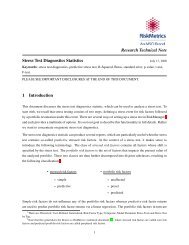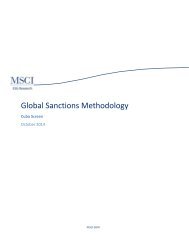Research Technical Note Credit VaR Change Attribution ... - MSCI
Research Technical Note Credit VaR Change Attribution ... - MSCI
Research Technical Note Credit VaR Change Attribution ... - MSCI
You also want an ePaper? Increase the reach of your titles
YUMPU automatically turns print PDFs into web optimized ePapers that Google loves.
<strong>Research</strong> <strong>Technical</strong> <strong>Note</strong><strong>Credit</strong> <strong>VaR</strong> <strong>Change</strong> <strong>Attribution</strong> August 1, 2012Keywords: <strong>VaR</strong> factor attribution, <strong>Credit</strong>Manager.PLEASE SEE IMPORTANT DISCLOSURES AT THE END OF THIS DOCUMENT.Contents1 Introduction 12 Methodology 13 Example 31 Introduction<strong>Credit</strong> <strong>VaR</strong> change attribution refers to the process of measuring risk changes generated by various sourcesof credit risk. <strong>Attribution</strong> of credit risk changes to factors can help an investor to verify his hedging performance,or provide guidance on how the portfolio has performed according to a directional bet on a givenfactor. It is important that the aggregation of attributed risk changes, gives the same value as the change ofrisk of portfolio when all the factors have moved from their previous states to current states. If this is notsatisfied, there will be unidentified sources of risk, and attribution methodology will be questionable.In this paper a new attribution methodology has been proposed for credit risk that is aligned with the <strong>Credit</strong>-Metrics methodology. Section 2 describes the details of the methodology, and Section 3 provides an exampleon how the methodology will generate risk attributions on a sample portfolio.2 Methodology<strong>Credit</strong> Value at Risk (<strong>VaR</strong>) can be written as the difference between two valuation functions.<strong>Credit</strong> <strong>VaR</strong> = −(V f −V b ) (1)1
Table 1: <strong>Credit</strong>Manager factors1 Aging; holding the same portfolio while keeping all the market conditions same, and repricing ata future date2 Risk free yields3 Spread by rating curves4 <strong>Change</strong> in currency rates (FX)5 Correlation between market indices6 Transition matrix change7 <strong>Change</strong> in exposure sizes and obligor properties (accounting for intra period trades, change ofclient’s view of recovery assumptions, obligor R 2 that defines the idiosyncratic return contributionto the asset return, and change of index weights of an obligor)where V f is the valuation of the portfolio at the tail scenario corresponding to the (1 − p)th quantile of theloss distribution (P(Horizon Value < V f ) = p). V b is the baseline for the loss distribution; which can bemean Horizon Value (HV), Current Value (CV) or base HV (which keeps the horizon date rating states sameas the ratings at the analysis date) depending on the client’s report settings.<strong>Credit</strong> <strong>VaR</strong> change between time t and t − 1 can be written aswhere m t i is the factor i at time t.∆<strong>VaR</strong> = − ( V f (m t i,...) −V b (m t i,...) ) + ( V f (m t−1i ,...) −V b (m t−1i ,...) ) (2)The list of factors that change the value of the portfolio through time in <strong>Credit</strong>Manager are listed in Table 1.One approach to change decomposition is to change variables one at a time:()∆<strong>VaR</strong> aging = − V f (m t aging,m t−1yields ,mt−1 spreads ,...) −V b(m t aging,m t−1yields ,mt−1 spreads ,...)+ ( V f (m t−1i ,...) −V b (m t−1i ,...) )∆<strong>VaR</strong> yields = −... = ...()V f (m t−1aging ,mt yields ,mt−1 spreads ,...) −V b(m t−1aging ,mt yields ,mt−1 spreads ,...)+ ( V f (m t−1i ,...) −V b (m t−1i ,...) )This approach does not result in additive attribution, and it can result in a large interaction term that needsto be separately calculated. This term can be quite large, and source of that is not explained∆<strong>VaR</strong> = ∆<strong>VaR</strong> aging + ∆<strong>VaR</strong> yields + ∆<strong>VaR</strong> spreads + ... + ∆<strong>VaR</strong> interactions (3)One might ask why there is no such interaction term in the case of position attribution (Incremental/Contribution<strong>VaR</strong>) for point in time <strong>VaR</strong>. The total value of the portfolio is a linear function of portfolio weights, and thusthe position level attribution just returns the prices of each position at the tail event. However in case of<strong>MSCI</strong> <strong>Research</strong>-<strong>Credit</strong>© <strong>MSCI</strong> Inc. All rights reserved.Please refer to the disclaimer at the end of this document.2
factor dependency, total <strong>VaR</strong> has nonlinear dependency to risk factors.One can construct an additive attribution methodology for <strong>VaR</strong> changes, by modifying factors sequentiallyrather than one at a time;()∆<strong>VaR</strong> aging = − V f (m t aging,m t−1yields ,mt−1 spreads ,...) −V b(m t aging,m t−1yields ,mt−1 spreads ,...)+ ( V f (m t−1i ,...) −V b (m t−1i ,...) )()∆<strong>VaR</strong> yields = − V f (m t aging,m t yields ,mt−1 spreads ,...) −V b(m t aging,m t yields ,mt−1 spreads ,...) ()+ V f (m t aging,m t−1yields ,mt−1 spreads ,...) −V b(m t aging,m t−1yields ,mt−1 spreads ,...)∆<strong>VaR</strong> spreads = − ( V f (m t aging,m t yields ,mt spreads ,...) −V b(m t aging,m t yields ,mt spreads(,...)))+ V f (m t aging,m t yields ,mt−1 spreads ,...) −V b(m t aging,m t yields ,mt−1 spreads ,...)... = ...Notice now that there is no need for an interaction term to make the sum of the attribution components matchto the change in <strong>VaR</strong> between two days.The caveat is additive attribution depends on the order of the factors. In order to remove the dependencyone option is to average over all the possible combinations of orders. This is computationally very intensive.Moreover the average values might not have a well defined meaning compared to a sequential change.We recommend instead the client uses a ”natural order” that is aligned with their investment process. Asan example clients performing fixed portfolio return attribution are faced with the same challenge. Mostportfolio tools perform fixed income attribution in the order of aging, risk free interest rates, spreads andvolatilities. The attribution would differ if spreads were moved before the interest rates, but this is notgenerally seen as a problem [1].3 ExampleAs an example we take a two bond portfolio, and investigate the attribution to a one month of change in<strong>Credit</strong> <strong>VaR</strong>. The baseline for <strong>VaR</strong> has been chosen as mean HV.Bonds’ terms and conditions are given as below;• Bond 1, Rating A par value 10 million USD, 6% coupon, R 2 =0.5, <strong>MSCI</strong> USD Energy, maturity at1/24/2020• Bond 2, Rating A par value 1 million USD, 4% coupon, R 2 =0.5, <strong>MSCI</strong> USD Financial, maturity at1/20/2021<strong>MSCI</strong> <strong>Research</strong>-<strong>Credit</strong>© <strong>MSCI</strong> Inc. All rights reserved.Please refer to the disclaimer at the end of this document.3
We consider the change of <strong>VaR</strong> between 8/29/2006 (t − 1) and 9/29/2006 (t). Synthetic market conditionsare created to illustrate the methodology. Spreads are increased at t by 1% from their levels at t − 1 inabsolute terms on each node, and correlations between <strong>MSCI</strong> USD Energy and Financial are increased by0.64 at time t from 0.26 at time t − 1.Table 2 shows the risk numbers at 98.8% <strong>VaR</strong> for 1 year horizon. The horizon values in a small investmentgrade bond portfolio are usually made up from a set of discrete values, since the probability of default 1 isvery low. Figure 1 displays the profit and loss distribution at the tail region. The <strong>VaR</strong> value is the negativeof P&L along the vertical 0.012 probability quantile, and the change corresponds to the difference betweenthe red and green curves at the same quantile. Discrete credit states around the tail region, can be clearlyidentified in this example. The portfolio has became less risky as a result of the changes in the marketconditions, thus ∆<strong>VaR</strong> has a negative sign. Table 3 shows the attribution following the sequential orderingin Table 1Table 2: <strong>VaR</strong> change in the example portfolio<strong>VaR</strong> t 447,434<strong>VaR</strong> t−1 476,478∆<strong>VaR</strong> -29,044Table 3: ∆<strong>VaR</strong> attribution∆<strong>VaR</strong> aging -2,601∆<strong>VaR</strong> yields 0∆<strong>VaR</strong> spreads -81,306∆<strong>VaR</strong> f x 0∆<strong>VaR</strong> correlation 54,863Sum of ∆<strong>VaR</strong> -29,044Table 4 shows the HV table at time t and t −1 for both bonds. <strong>VaR</strong> quantile scenario at time t −1 correspondsto Bond 1 at Baa and Bond 2 at A rating level. The change in the horizon values due to aging can be furtherattributed to two separate effects. First is income effect; due to the cash flows from the coupon paymentsand the changes in accrued interests. Second is the roll down effect; where the value of the security changesdue to the passage of time. Roll down effect captures the change in the clean price of the bond. HVs at timet in Table 4 are mostly increasing because of the income effect. However the contribution of roll down effectis greater, since the accrued cash flows also increase the mean HV by almost the same amount as the HVs atthe rating state which determines the <strong>VaR</strong> quantile (∆<strong>VaR</strong> due to income is +2 while ∆<strong>VaR</strong> due to roll downis -2,603) .1 <strong>Credit</strong>Manager simulates continous recovery distribution when the obligor is in default, which generates continuity in the profitand loss distributions<strong>MSCI</strong> <strong>Research</strong>-<strong>Credit</strong>© <strong>MSCI</strong> Inc. All rights reserved.Please refer to the disclaimer at the end of this document.4
Table 4: HV changes due to agingHorizon Values (t-1) Horizon Values(t) Transition Probabilities t-(t-1)Aaa 12,529,084 12,573,873 0.05% 44,789Aa 12,251,284 12,297,949 2.51% 46,665A 11,789,560 11,838,555 90.99% 48,995Baa 11,276,594 11,328,350 5.59% (#1) 51,756Ba 10,159,602 10,215,279 0.63% 55,677B 9,678,548 9,734,886 0.20% 56,338Caa 9,228,768 9,284,939 0.02% 56,171Default 6,524,729 6,556,833 0.01% 32,104Bond 1 Mean HV 11,757,315 11,806,460 (#2) 49,145Aaa 959,469 963,460 0.05% 3,991Aa 923,651 927,841 2.51% 4,190A 864,627 869,001 90.99% (#3) 4,374Baa 796,073 800,657 5.59% 4,584Ba 657,868 662,607 0.63% 4,739B 602,506 607,154 0.20% 4,648Caa 557,422 561,894 0.02% 4,472Default 358,477 359,666 0.01% 1,189Bond 2 Mean HV 860,385 864,769 (#4) 4,384Sum of Bond 1 at (#5) 56,130Baa & Bond 2 at A(#1+#3)Sum of Mean HV (#6) 53,529for Bond 1 & Bond2 (#2+#4)(#6 - #5) =∆<strong>VaR</strong> aging -2,601<strong>MSCI</strong> <strong>Research</strong>-<strong>Credit</strong>© <strong>MSCI</strong> Inc. All rights reserved.Please refer to the disclaimer at the end of this document.5
Table 5 shows the change in HVs due to the increase in spreads. <strong>VaR</strong> goes down even though the spreads areincreased in all rating levels. The spread increase causes the HVs in all rating states to decrease in value, buthigher rating states decrease more in absolute terms. As a result the mean horizon value goes down morethan HV of the <strong>VaR</strong> quantile scenario.Table 6 shows the effect of increase in the correlation. As the market indices become more correlated, theprobability of assets going to lower (and also higher) states gets larger. At the <strong>VaR</strong> quantile, Bond 2 hasdropped its rating to Baa, while Bond 1 has stayed in Baa rating. The impact of correlation on P&Ls in thetail can also be seen in Figure 1 where the green curve has a different distribution shape compared to theother curves, because of the increased probabilities of transitions to lower ratings.Table 5: HV changes due to spreadsHorizon Values (t) Horizon Values (t) with spread t-(t-1)Baa 11,328,350 10,757,362 (#1) -570,988Bond 1 Mean HV 11,806,460 11,153,361 (#2) -653,099A 869,001 784,529 (#3) -84,472Bond 2 Mean HV 864,768 781,100 (#4) -83,668Sum of Bond 1 Baa & Bond 2 A (#5) -655,460(#1+#3)Sum of Mean HV for Bond 1 & (#6) -736,767Bond 2 (#2+#4)∆<strong>VaR</strong> spreads ( #6-#5) -81,307Table 6: Bond 2 HV changes due to correlationHorizon Values (t) with spread Transition ProbabilitiesAaa 857,632 0.05%Aa 830,626 2.51%A (#1) 784,529 90.99% initialBaa (#2) 729,665 5.59% finalBa 618,999 0.63%B 574,358 0.20%Caa 538,505 0.02%Default 359,666 0.01%Baa-A (#1-#2) ∆<strong>VaR</strong> correlation =54,864<strong>MSCI</strong> <strong>Research</strong>-<strong>Credit</strong>© <strong>MSCI</strong> Inc. All rights reserved.Please refer to the disclaimer at the end of this document.6
correlation∆<strong>VaR</strong>spreadsagingFigure 1: Profit and Loss (PnL) distribution<strong>MSCI</strong> <strong>Research</strong>-<strong>Credit</strong>© <strong>MSCI</strong> Inc. All rights reserved.Please refer to the disclaimer at the end of this document.7
References[1] A. Colin. Fixed Income <strong>Attribution</strong>. Wiley Finance, 2005.<strong>MSCI</strong> <strong>Research</strong>-<strong>Credit</strong>© <strong>MSCI</strong> Inc. All rights reserved.Please refer to the disclaimer at the end of this document.8
Client Service Information is Available 24 Hours a Dayclientservice@msci.comAmericas Europe, Middle East & Africa Asia PacificAmericas + 1.888.588.4567 (toll free) Amsterdam + 31.20.462.1382 China North 10800.852.1032 (toll free)Atlanta + 1.404.551.3212 Cape Town + 27.21.673.0100 China South 10800.152.1032 (toll free)Boston + 1.617.532.0920 Frankfurt + 49.69.133.859.00 Hong Kong + 852.2844.9333Chicago + 1.312.675.0545 Geneva + 41.22.817.9777 Seoul +827.0768.88984Montreal + 1.514.847.7506 London + 44.20.7618.2222 Singapore 800.852.3749 (toll free)Monterrey + 52.81.1253.4020 Madrid + 34.91.700.7275 Sydney + 61.2.9033.9333New York + 1.212.804.3901 Milan + 39.02.5849.0415 Tokyo + 81.3.5226.8222San Francisco + 1.415.836.8800 Paris 0800.91.59.17 (toll free)Sao Paulo + 55.11.3706.1360 Zurich + 41.44.220.9300Stamford +1.203.325.5630Toronto + 1.416.628.1007Notice and Disclaimer• This document and all of the information contained in it, including without limitation all text, data, graphs, charts (collectively, the “Information”)is the property of MSCl Inc., its subsidiaries (including without limitation Barra, Inc. and the RiskMetrics Group, Inc.) and/ortheir subsidiaries (including without limitation the FEA, ISS, and CFRA companies) (alone or with one or more of them, “<strong>MSCI</strong>”), or theirdirect or indirect suppliers or any third party involved in the making or compiling of the Information (collectively (including <strong>MSCI</strong>), the“<strong>MSCI</strong> Parties” or individually, an “<strong>MSCI</strong> Party”), as applicable, and is provided for informational purposes only. The Information maynot be reproduced or redisseminated in whole or in part without prior written permission from the applicable <strong>MSCI</strong> Party.• The Information may not be used to verify or correct other data, to create indices, risk models or analytics, or in connection with issuing,offering, sponsoring, managing or marketing any securities, portfolios, financial products or other investment vehicles based on, linked to,tracking or otherwise derived from any <strong>MSCI</strong> products or data.• Historical data and analysis should not be taken as an indication or guarantee of any future performance, analysis, forecast or prediction.• None of the Information constitutes an offer to sell (or a solicitation of an offer to buy), or a promotion or recommendation of, any security,financial product or other investment vehicle or any trading strategy, and none of the <strong>MSCI</strong> Parties endorses, approves or otherwiseexpresses any opinion regarding any issuer, securities, financial products or instruments or trading strategies. None of the Information,<strong>MSCI</strong> indices, models or other products or services is intended to constitute investment advice or a recommendation to make (or refrainfrom making) any kind of investment decision and may not be relied on as such.• The user of the Information assumes the entire risk of any use it may make or permit to be made of the Information.• NONE OF THE <strong>MSCI</strong> PARTIES MAKES ANY EXPRESS OR IMPLIED WARRANTIES OR REPRESENTATIONS WITH RESPECTTO THE INFORMATION (OR THE RESULTS TO BE OBTAINED BY THE USE THEREOF), AND TO THE MAXIMUM EXTENTPERMITTED BY LAW, <strong>MSCI</strong>, ON ITS BEHALF AND ON THE BEHALF OF EACH <strong>MSCI</strong> PARTY, HEREBY EXPRESSLY DIS-CLAIMS ALL IMPLIED WARRANTIES (INCLUDING, WITHOUT LIMITATION, ANY IMPLIED WARRANTIES OF ORIGINAL-ITY, ACCURACY, TIMELINESS, NON-INFRINGEMENT, COMPLETENESS, MERCHANTABILITY AND FITNESS FOR A PAR-TICULAR PURPOSE) WITH RESPECT TO ANY OF THE INFORMATION.• Without limiting any of the foregoing and to the maximum extent permitted by law, in no event shall any of the <strong>MSCI</strong> Parties haveany liability regarding any of the Information for any direct, indirect, special, punitive, consequential (including lost profits) or any otherdamages even if notified of the possibility of such damages. The foregoing shall not exclude or limit any liability that may not by applicablelaw be excluded or limited, including without limitation (as applicable), any liability for death or personal injury to the extent that suchinjury results from the negligence or willful default of itself, its servants, agents or sub-contractors.• Any use of or access to products, services or information of <strong>MSCI</strong> requires a license from <strong>MSCI</strong>. <strong>MSCI</strong>, Barra, RiskMetrics, ISS, CFRA,FEA, EAFE, Aegis, Cosmos, BarraOne, and all other <strong>MSCI</strong> product names are the trademarks, registered trademarks, or service marksof <strong>MSCI</strong> in the United States and other jurisdictions. The Global Industry Classification Standard (GICS) was developed by and is theexclusive property of <strong>MSCI</strong> and Standard & Poor’s. “Global Industry Classification Standard (GICS)” is a service mark of <strong>MSCI</strong> andStandard & Poor’s.9
















